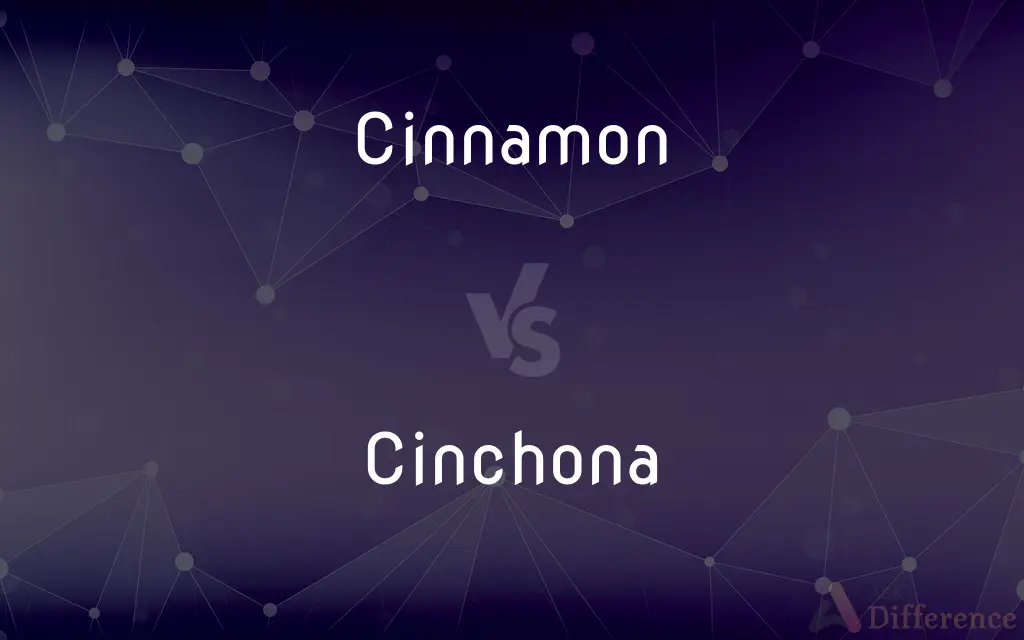Cinnamon vs. Cinchona — What's the Difference?
By Tayyaba Rehman — Updated on September 24, 2023
"Cinnamon" is a spice obtained from the inner bark of certain trees, while "Cinchona" is a tree known for its bark that contains quinine.

Difference Between Cinnamon and Cinchona
Table of Contents
ADVERTISEMENT
Key Differences
"Cinnamon" is recognized for its aromatic and flavorful characteristics, often used in cooking and baking. Its sweet and warming fragrance enhances numerous dishes, from sweet to savory. On the other hand, "Cinchona" is a South American tree, specifically known for its medically beneficial bark. The bark of the "Cinchona" tree is the source of quinine, an agent used to treat malaria.
"Cinnamon" can be found in various forms such as sticks, ground powder, or as an essential oil. It's a staple in various cuisines, especially in baking, giving a delightful taste to bread, cakes, and cookies. "Cinchona", contrastingly, has been historically pivotal in medicine. The extraction from its bark, quinine, has saved countless lives from the threat of malaria.
Originating primarily from Sri Lanka, "Cinnamon" has found its way into kitchens around the globe, making it an integral part of various cultural dishes. In a distinct journey, "Cinchona" has its roots in the mountainous regions of South America, with its medicinal bark playing a crucial role in colonial expeditions to these territories.
While both "Cinnamon" and "Cinchona" relate to barks of trees, their uses are distinctively varied. One enhances flavor and aroma in culinary arts, and the other stands as a beacon in the history of medicine.
Comparison Chart
Primary Use
Culinary spice.
Source of quinine for malaria treatment.
ADVERTISEMENT
Origin
Mainly Sri Lanka.
South America.
Form
Sticks, ground powder, essential oil.
Bark extracts.
Associated Characteristics
Sweet, aromatic.
Medicinal.
Historical Significance
Culinary traditions across cultures.
Colonial expeditions & medicine.
Compare with Definitions
Cinnamon
Contains compounds beneficial for health.
Cinnamon tea can have antioxidant properties.
Cinchona
A tree with bark that contains quinine.
Cinchona bark played a vital role in treating malaria.
Cinnamon
Used in both sweet and savory dishes.
I sprinkled cinnamon on my oatmeal.
Cinchona
Various species with varying quinine concentrations.
Different cinchona species were sought after for their medicinal value.
Cinnamon
Aromatic tree native to Sri Lanka.
The cinnamon tree flourishes in tropical climates.
Cinchona
Historically significant in medicine.
Cinchona's discovery was groundbreaking for early explorers.
Cinnamon
Also available as an essential oil.
The scent of cinnamon oil filled the room.
Cinchona
Native to mountainous regions of South America.
The cinchona tree thrives in the Andes.
Cinnamon
Cinnamon is a spice obtained from the inner bark of several tree species from the genus Cinnamomum. Cinnamon is used mainly as an aromatic condiment and flavouring additive in a wide variety of cuisines, sweet and savoury dishes, breakfast cereals, snackfoods, tea and traditional foods.
Cinchona
Used to produce tonic water.
Tonic water's bitterness comes from cinchona extract.
Cinnamon
An aromatic spice made from the peeled, dried, and rolled bark of a SE Asian tree
A cinnamon cake
A teaspoon of ground cinnamon
Cinchona
Cinchona (pronounced or ) is a genus of flowering plants in the family Rubiaceae containing at least 23 species of trees and shrubs. All are native to the tropical Andean forests of western South America.
Cinnamon
The tree which yields cinnamon.
Cinchona
Any of various evergreen trees and shrubs of the genus Cinchona, native chiefly to the Andes, some species of which are cultivated for their bark, which contains quinine and other alkaloids used chiefly to treat malaria.
Cinnamon
The dried aromatic inner bark of certain tropical Asian trees of the genus Cinnamomum, especially C. verum and cassia (C. aromaticum), often ground and used as a spice.
Cinchona
The dried bark of any of these plants. Also called Jesuit's bark, Peruvian bark.
Cinnamon
A tree yielding this bark.
Cinchona
A tree or shrub of the genus Cinchona, native to the Andes in South America but since widely cultivated in Indonesia and India as well for its medicinal bark.
Cinnamon
A light reddish brown.
Cinchona
The bark of these plants, which yield quinine and other alkaloids useful in reducing fevers and particularly in combatting malaria.
Cinnamon
Flavored with cinnamon.
Cinchona
(medicine) Any medicine chiefly composed of the prepared bark of these plants.
Cinnamon
Of a light reddish brown.
Cinchona
A genus of trees growing naturally on the Andes in Peru and adjacent countries, but now cultivated in the East Indies, producing a medicinal bark of great value.
Cinnamon
(countable) A small evergreen tree native to Sri Lanka and southern India, Cinnamomum verum or Cinnamomum zeylanicum, belonging to the family Lauraceae.
Cinchona
The bark of any species of Cinchona containing three per cent. or more of bitter febrifuge alkaloids; Peruvian bark; Jesuits' bark.
Cinnamon
Several related trees, notably the Indonesian cinnamon (Cinnamomum burmanni) and Chinese cinnamon or cassia (Cinnamomum aromaticum or Cinnamomum cassia).
Cinchona
Any of several trees of the genus Cinchona
Cinnamon
A spice from the dried aromatic bark of the cinnamon tree, either rolled into strips or ground into a powder. The word is commonly used as trade name for spices made of any of the species above.
Cinnamon
, the product made of Cinnamomum verum
Cinnamon
(countable) A warm yellowish-brown color, the color of cinnamon.
Cinnamon
Containing cinnamon, or having a cinnamon taste.
Cinnamon
Of a yellowish-brown color.
Cinnamon
The inner bark of the shoots of Cinnamomum Zeylanicum, a tree growing in Ceylon. It is aromatic, of a moderately pungent taste, and is one of the best cordial, carminative, and restorative spices.
Cinnamon
Aromatic bark used as a spice
Cinnamon
Tropical Asian tree with aromatic yellowish-brown bark; source of the spice cinnamon
Cinnamon
Spice from the dried aromatic bark of the Ceylon cinnamon tree; used as rolled strips or ground
Cinnamon
A fragrant spice from tree bark.
Cinnamon rolls are a popular breakfast treat.
Common Curiosities
Is "Cinnamon" beneficial for health?
Yes, "Cinnamon" has compounds that offer health benefits like antioxidant properties.
Where is "Cinchona" primarily found?
"Cinchona" is native to the mountainous regions of South America.
Are there different types of "Cinnamon"?
Yes, the two main types are Ceylon (true) and Cassia cinnamon.
Why is "Cinchona" significant?
"Cinchona" is the source of quinine, historically used to treat malaria.
Can "Cinnamon" be used in drinks?
Yes, "Cinnamon" is often used in teas, coffees, and other beverages.
How did "Cinchona" get its name?
"Cinchona" is named after the Countess of Chinchón, who was reportedly cured of malaria with its bark.
Can both "Cinnamon" and "Cinchona" be consumed?
Yes, "Cinnamon" is a culinary spice, and "Cinchona" bark is used in tonic water.
Are there any side effects to consuming "Cinchona"?
Excessive quinine can lead to side effects; it's crucial to consult a medical expert.
How is "Cinnamon" typically sold?
"Cinnamon" is sold as sticks, ground powder, or essential oil.
Is quinine still used in medicine?
Yes, quinine from "Cinchona" is still used, especially in areas with drug-resistant malaria.
Is "Cinnamon" only used in desserts?
No, "Cinnamon" is versatile and used in both sweet and savory dishes.
Share Your Discovery

Previous Comparison
Reconstruct vs. Revise
Next Comparison
Scholar vs. ExpertAuthor Spotlight
Written by
Tayyaba RehmanTayyaba Rehman is a distinguished writer, currently serving as a primary contributor to askdifference.com. As a researcher in semantics and etymology, Tayyaba's passion for the complexity of languages and their distinctions has found a perfect home on the platform. Tayyaba delves into the intricacies of language, distinguishing between commonly confused words and phrases, thereby providing clarity for readers worldwide.















































